Whenever you think of the morning, the first thing that usually comes to mind is coffee. The caffeinated drink has been popular for decades, and unless you've been living under a rock, you are very well acquainted with the craze. Most of us swear by it and can't wake up in the morning without it.
Despite coffee's popularity, it might not be the healthiest of habits that we have adopted. It isn't too hard to become addicted, and with the addition of milk and sugar, can pack on unwanted calories and dependance. Luckily, there is an alternative that might not give you the caffeine rush that coffee is known for, but is a close second that provides added health benefits as well — tea.
Tea has been used and loved all around the globe for centuries. There are hundreds of types to choose from to accommodate everyone, with each having their own benefits. Herbal teas can be used to nurture and cleanse the body. Then there are drinks like green tea that can lengthen your lifespan while also giving you enough caffeine for your morning commute. But, to explore the world of tea and try each of them out for yourself, you will need to invest in a tea kettle.
While tea kettles are not completely necessary to make a cup of tea, they make the process a lot simpler and faster. While heating water in a pot or in the microwave can do the job, the temperature will not be consistent or accurate to make the perfect batch.
Today, we will be discussing everything you need to know about tea kettles so that you can decide if it has a place in your kitchen to make as much tea as you like. Knowing how tea kettles work, the difference between a tea kettle and a teapot, types of tea kettles, and more will be taught to give you a clear idddcddcdfxof what they can bring to the table. Without further ado, fc cccbxxccfdcvfcet's get started.
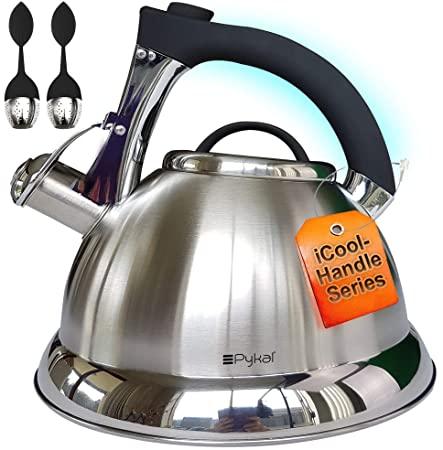
What are Tea Kettles?
Even though tea kettles have been around for centuries, many of us are still not very acquainted with them. A tea kettle is a container that boils water. They come in many shapes and sizes, but the characteristics that they share is that they have a spout, a lid, and a handle to make handling the water easy enough to make tea.
There are quite a few types as well, which we will talk about in the following sections, and they are not to be confused with teapots. While their primary purpose is to help make tea, they can also be used to heat water for noodles or other drinks like lemon water.
How Do Tea Kettles Work?
At this point we know that a tea kettle’s job is to heat up and boil water, but how do they do it? The best way to deepen our understanding of it is by knowing that there are two major types, the traditional and electric tea kettle.
The traditional tea kettle is one we have either seen or heard at some point, whether from home or television. They can be made of a variety of metals that make them resistant to heat, with a lid and handle attached to contain the steam within the pot and to make it safe to lift. With these, you place the kettle on a stovetop, put the desired amount of water inside, and heat it.
The main thing that makes tea kettles more desirable to heat water compared to microwave methods is that you know when the water has reached its boiling point.
While many have researched trying to find out what makes tea kettles whistle, there is still no definitive answer. It is theorized that the more steam created in the pot, the less room it has to pass through the spout. So, the more steam there is that can't pass through in a given time, the more it whistles. At its height is when it starts to scream and that's how you know your water is ready.
An electric tea kettle works similarly and has the same basic construction as a traditional tea kettle. What sets it apart is that it does not need a stovetop to its job. They are constructed using different metals, with most on the market being combined with plastic materials as well.
While different manufacturers use different materials and methods, most work through running an electrical current through a source such as a metal coil or something similar. The current creates resistance within the element to turn its energy into heat.
Since the coil is submerged in cold water, it can heat it directly. In some models, there is a metal plate separating the heat source and the water to make it more efficient and flattering. Many on the market have a separate power unit apart from the container, where you place the kettle on top and turn on to generate heat.
The lid works the same way in making sure that the steam is contained as much as possible. But, there is no whistling like you would find on a stovetop kettle, so how would you know that the water is done? Electric kettles have internal temperature control that allows it to turn off automatically when it is done boiling. In most, it is a faint, but audible click that lets you know when it is ready for tea.
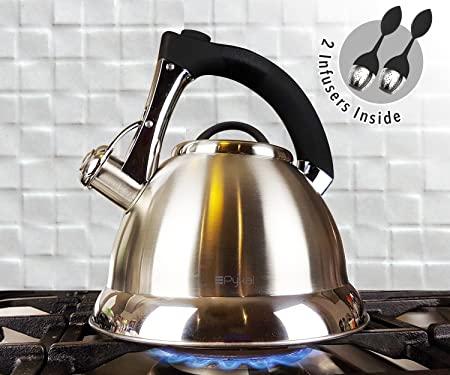
History of Tea Kettles
The history of tea kettles is an unclear one. To many researchers, it appears that many of them were created unintentionally. Even though there is no specific time, its roots can be traced back to the days of ancient China. During this time, they heated water in an attempt to get rid of impurities and added green leaves to see what would happen. In that instance, tea was created, and so was the kettle.
This occurrence was traced back to other parts of the world as well. It was also seen with travelers in different areas of Europe doing the same thing but adding wheat grain to the water, creating malt beer. In North America, it was coffee. The earliest materials used were bronze and iron and looked a lot like the stovetop tea kettles that we use today.
The popularity started to grow when the Chinese refined this method of heating water by making porcelain tea kettles and china that appealed to other parts of the world. With traveling and trading, the tea kettle and other appliances from that time became more known and used by everyone.
Tea became a popular drink all around the world, with significant movements happening in places like England and France in the 18th century. Russians and Indians created their own designs of the tea kettle to appeal to their culture and style as well.
In the early 1900s, the invention of the electric tea kettle came about and changed the tea making world, thanks to the Swan company in 1922. Although they weren't the first to come up with the concept of the electric kettle, they did create the one that we use today. The ones made earlier in the decade had the same idea, but the heating source was still separate from the kettle itself.
Even though this version of the tea kettle significantly improved the ways that water was heated for food and tea, it wasn't until the 1950s that the tea kettle reached its peak.
A company called Russell Hobbs created a kettle that turned off automatically, changing the game for all the ones to come. The ones before didn’t have a shutoff point and would keep going until the water was evaporated. They were also known for causing electric shocks from being on for too long.
From here, companies over the decades have taken the invention and reinvented it in their own unique way to make the products sitting on kitchen counters everywhere.
Teapot Vs. Tea Kettle — Is There a Difference?
Usually, when you hear the term teapot, you may think of tea kettles as well. Many people believe that they are just two names to describe one object, but they are very different. The main difference is that one is used to heat water while the other is used to store it and brew the tea.
Both look very similar in that they can have the same shape with a spout, lid, and handle, but are usually made out of different materials. Most stovetop tea kettles are made with various forms of metal to make them resistant and durable against direct heat. Electric tea kettles can contain metal as well but can have plastic parts to make them long-lasting. Most teapots have neither.
While they are constructed to be heat-resistant, they are not designed to come into contact with direct heat. Most are made up of porcelain, glass, or ceramic materials that can melt or crack when placed on a stove, but are great for locking in heat to ensure that the water or tea that is inside doesn’t get cold.
Another difference, which you may have guessed by their purposes is that tea kettles are not able to brew actual tea. Teapots are specialized in doing this, hence their name, and just like in the way the lid on tea kettles hold in steam, the cap on teapots does the same to infuse the tea bags with enough heat to give it a clean, rich flavor.
It is also for this reason that teapots have one purpose, while tea kettles are not limited to just helping in the tea process. Hot water can be used for any purpose, but teapots are only really good at keeping tea warm.
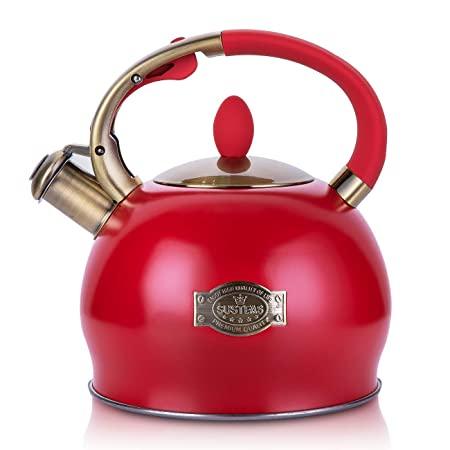
Types of Tea Kettles
Outside of the two main types, stovetop and electric, there are a multitude of variations within each category to become acquainted with if you are looking to have one of your own. Finding the perfect one boils down to personal preference, as each one has its own set of pros and cons.
Stainless Steel Tea Kettles
Perhaps one of the most popular tea kettles on the market is stainless steel. This material ensures longevity in terms of use and appearance and is one of the more affordable options out of the types. The great thing about stainless steel is that you have more choices when it comes to design since the material leaves enough room for added color without affecting the taste of the water.
The material is strong, durable, and is resistant to wear and tear, so if you want a tea kettle that doesn't require much maintenance and will look brand new for years to come, this is the one to go with. One of its downsides is that it takes a little longer to heat up compared to other materials, but because of this, the water heats evenly throughout.
With these kettles, it is worth noting that the body can get very hot, so they need to be handled with care when using. As long as you don't choose one that also has a handle that is also made out of stainless steel, you should be good to go.
Cast Iron Tea Kettles
Cast iron tea kettles have been a favorite for centuries, as iron is one of the first materials used when they were first created. They are still popular today and allow you to bring in that antique style that has been lost over the years right to your kitchen counter. Their style is loved by many tea enthusiasts thanks to the rawness of its appearance and its infusion of the culture that tea is thought of to be bred from.
There are quite a few downsides when it comes to using these kettles, but many worthy qualities to make up for it. For one, it is known for improving the taste of tea if you buy one of good quality. Heating water in iron changes its particles and can create softer, richer tasting tea that has more depth and less bitterness. Plus, it small quantities, added iron can be beneficial when consumed in moderation.
A few of the downsides of having one of these classics is that they are very high maintenance. Despite the ability to last a long time, they will eventually rust. There are a few measures in place to slow down the process, but when burning iron, it is nearly inevitable. Also, just like with stainless steel, they can take a while to bring water to a boil but keeps it hotter for longer.
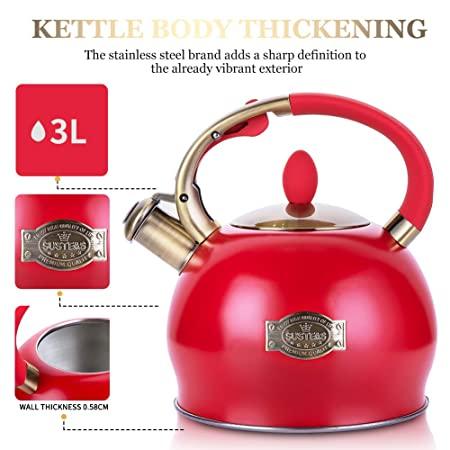
Copper Tea Kettles
The next type of kettle that we will discuss is copper. These have the same adoration from tea enthusiasts as cast iron tea kettles due to their antique appearance and style. The best thing about copper tea kettles is that copper conducts heat faster than any other material used for these products, so it can heat water on lower heat settings in a fraction of the time.
Another added advantage is that they will not rust over time, like cast iron and stainless steel models. However, they are prone to tarnishing, so to keep up with their sleek and beautiful design, you will have to do more to maintain it. It is still better than rusting since it is reversible and doesn’t leak into the water you are boiling.
Copper is a softer material, making it not as durable but still long-lasting. Besides polishing, you will need to be sure to handle it with care so that no denting or scratching occurs to keep them looking brand new.
Glass Tea Kettles
Another type that you wouldn't think likely on first thought is glass tea kettles. Also not as durable as the other materials in this section, they are designed to get the job done while providing a chic and simple look to your kitchen. The best thing about glass is that you won't have to worry about any residue of the material finding its way into the water, and it requires low maintenance.
With these, you will need to make sure that the product is of high quality so that there is no chance that the glass will break prematurely, and that you are careful when handling since glass can become very hot.
Enamel Tea Kettles
Enamel tea kettles are tea kettles made with plastic. While we know that plastic is generally made with harsher chemicals, these are made up of another material to lessen the amount of plastic used. These kettles add in enamel to make them easier to clean and to improve the overall look of the product, typically with stainless steel.
You may also find enamel used in specially designed cast iron tea kettles to reduce the amount of rust on the inside.
Electric Tea Kettles
As mentioned, electric tea kettles can be made out of plastic, but it is not uncommon to find them in glass, stainless steel, or even ceramic.
The advantage that electric tea kettles have over most of the kettles on this list is that the materials are usually heatproof, so they can be handled and used without the fear of getting burned. The one downside that many tea lovers have is that some of the harsh materials used in making the plastic can transfer, with some leading to health risks further down the line.
How to Properly Clean a Tea Kettle
Depending on the type of tea kettle you choose to have, the cleaning process may be a breeze or tedious after each use. But a general rule of thumb, no matter the kind, is washing with soap and water like with most kitchen appliances.
The trick to staying on the safe side, however, is to clean and dry your tea kettle thoroughly to ensure that it lasts a long time. For materials like iron, copper, and stainless steel, this is even more important since long periods of water exposure can lead to rust and other issues.
If you are looking to make sure that no residue from the tea is left behind, you can add a mixture of vinegar and water, bring to a boil, and rinse to get a deeper clean.
If your kettle starts to rust or tarnish, there are a few methods that you can use to get rid of it. For copper, polishing it with things like tomato paste at the first signs of tarnish will get the kettle looking like new again instantly. For stainless steel, the same can be achieved with baking soda.
Cast iron tea kettles tend to have very in-depth procedures for maintenance, but when it comes to cleaning, the main thing to remember is not to use abrasive household materials and pat dry immediately after use.
Most kettles that are made out of stainless steel, plastic, or glass are dishwasher safe; make sure that you read the instructor's manual before doing so.
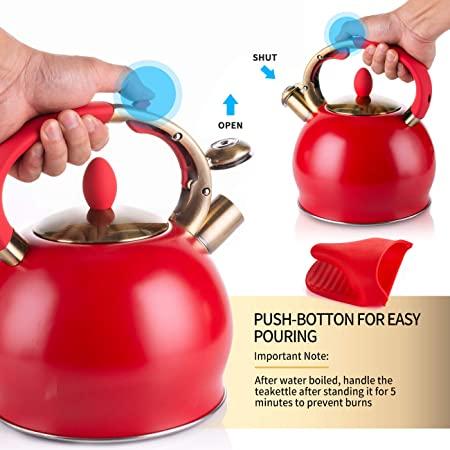
Conclusion
So there you have it, an in-depth guide to everything tea kettle, from how they came to be right down to how to keep them clean. Making tea can be a great change of pace for coffee lovers out there and can be an excellent source for making you healthier. There are so many variations to choose from, which can be overwhelming and can seem like a waste of time to those that don't appreciate tea but making sure that you have the right one for your needs can impact the flavor and quality dramatically.
We hope that this article has helped you understand tea kettles a little better.
Resources:
